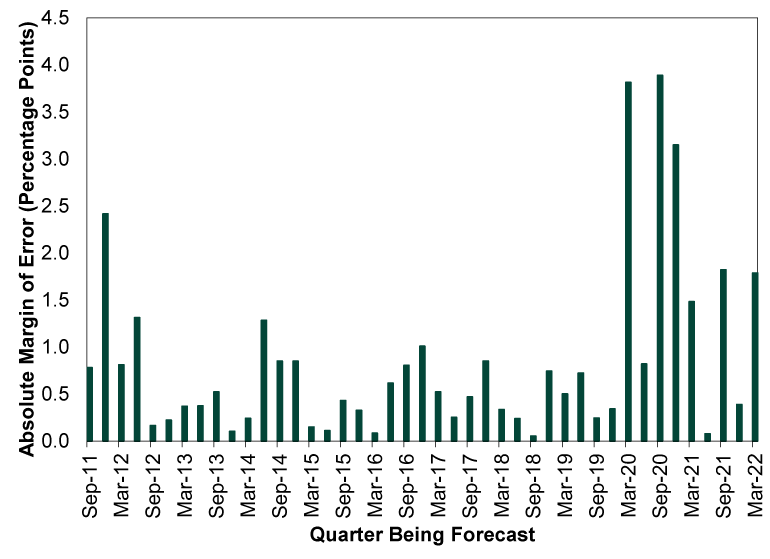Personal Wealth Management / Market Analysis
What Now, GDP Nowcast?
Purported real-time GDP trackers get heaps of attention, but their models aren’t airtight.
They don’t always, but bear markets often precede recessions. So US stocks’ breaching -20% on June 13 poured gasoline on already hot recession fears. Given that backdrop, it shouldn’t surprise you that the Atlanta Federal Reserve’s GDPNow—a statistical model designed to estimate the quarter’s GDP based on incoming data and forecasts—falling to -2.1% annualized for Q2 on July 1 further fanned fears. While we don’t dismiss the possibility of a Q2 contraction, which would technically be the second-straight quarterly decline, we think there are reasons to be skeptical this outcome is assured. Or that it means America would be in recession.
The Atlanta Fed’s tool is one of several like it that aggregate incoming data, math it up and try to predict the eventual GDP release. It mashes together Fed forecasts and actual data releases, evolving throughout the quarter as data arrive. It also, the Atlanta Fed wants you to know, isn’t the bank’s official forecast. It is a research exercise above all else, based largely on ideas cooked up in the private sector.
As you might imagine, the earlier in the quarter one looks at GDPNow, the less accurate the “nowcast” tends to be. But even at quarter end, when most data are in, tracking error exists. And it is up since the pandemic. That doesn’t mean GDPNow is wrong or useless. It just means handle with caution because, like all economic data, it is far from perfect—especially given the oddity of 2020’s lockdown-driven downturn. Exhibit 1 shows GDPNow’s historical tracking error on the day before the US Bureau of Economic Analysis published the relevant quarter’s advance GDP estimate. (This quarter, that would be on July 27.)
Exhibit 1: Tracking Error on Eve of Release Up Since Pandemic

Source: Federal Reserve Bank of Atlanta, as of 7/6/2022.
Now, that is the absolute error—the magnitude of the difference, not the direction—meaning that skew doesn’t necessarily mean the actual GDP result will exceed GDPNow’s eventual prediction on July 27. Actually, GDPNow has more often overstated than understated the outcome, but that isn’t assured and the dataset is really small. We simply think it is an error to take nowcasts—which will evolve from here as more data arrive—to the bank. The methodology largely explains the skew. For example, July 1’s -1.1 percentage point drop to the nowcast’s contraction is mostly underpinned by a reduction in the estimate of Q2 real personal consumption expenditures (PCE) from 1.7% annualized to 0.8%.[i] That wasn’t due to an actual report on PCE, though. It is imputed from the Institute for Supply Management’s Manufacturing PMI. We are sure the Atlanta Fed has its statistical logic for doing so, but in a period when consumer spending has been shifting from goods to services bigtime, that seems potentially problematic.
Again, we aren’t saying this tool is wrong or useless. We aren’t siding with the St. Louis Fed’s Economic News Index nowcast, which currently projects 3.9% annualized growth.[ii] Nor are we suggesting these bodies follow the New York Fed’s lead and pause their nowcasts, pending recalculation and methodology changes post-pandemic. All data have their limitations, and these nowcasts helpfully aggregate things for investors to consume.
Still, maybe the Atlanta Fed’s gauge is right and we do get another quarterly contraction. Some would likely dub that a recession. (Of course, America doesn’t define a recession as two straight quarters of negative GDP. The fun folks at the National Bureau of Economic Research’s Business Cycle Dating Committee determine when we are in one—at a long lag.) But you can find recession chatter on virtually every financial media outlet anywhere quite easily and prominently. That suggests to us that the risk of recession is factored into markets to a very large extent today. In our view, it would take quite a lot to negatively shock stocks for long now.
HT: Fisher Investments Research Analyst Ben Lederer.
If you would like to contact the editors responsible for this article, please message MarketMinder directly.
*The content contained in this article represents only the opinions and viewpoints of the Fisher Investments editorial staff.
Get a weekly roundup of our market insights
Sign up for our weekly e-mail newsletter.

You Imagine Your Future. We Help You Get There.
Are you ready to start your journey to a better financial future?

Where Might the Market Go Next?
Confidently tackle the market’s ups and downs with independent research and analysis that tells you where we think stocks are headed—and why.





